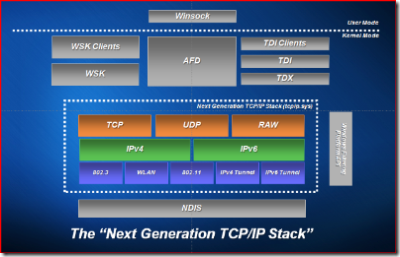Hey TCP! What Have You Done for Me Lately?
Let's face it, the Internet is running on some old protocols. TCP, for example, was originally proposed in an RFC that dates back to 1981. That's not to say these protocols and communication services aren't up to the task at the ripe old age of 25 or so years old. Instead, it begs the question: how can this heavily embedded, well accepted method for connecting two hosts evolve to meet the changing networking landscape?
That was a question posed in a recent series of of Network World "Network Optimization Newsletters" under the topic of "Time for new TCP"?
In the latest round of reader responses, entitled "More thoughts on alternates to today's TCP", Joe Skorupa of Gartner spoke very positively of the work we did on the new TCP/IP stack in Windows Vista and Windows Server "Longhorn" (affectionately called "NetIO" and pictured below)
Here's what Joe had to say:
"If you want to improve TCP, just implement the fixes detailed in a series of IETF standards (including RFCs 3390, 2582, 2883 3517 and 4138). They include fast ramp, selective acknowledgement, large transmit and receive windows and explicit congestion notification. These are now standards, are well understood and have been tested by a large community and have been shown to work well," Skorupa explains. "Additionally, many [WAN optimization controller] vendors incorporate most of these features and Microsoft’s new TCP stack for Vista/Longhorn has excellent support for this approach."
Joe's referring to the long list of performance improvements already available to users of Windows Vista (like me...okay, that's not fair to rub that in, but the consumer launch is coming up real fast) and will be a standard experience in Windows Server "Longhorn".
Sound good to you? Start your testing today!
